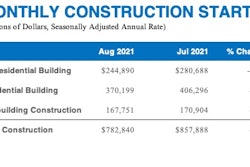
Civil contractors expressed a positive outlook for work volumes for 2021 and 2022, despite rising concerns over the ability to meet workforce and skills needs on infrastructure projects.
Respondents to Dodge Data & Analytics' Civil Quarterly, a quarterly snapshot of current contractor business health, are optimistic they will have sufficient workloads in the coming months and expect subsequent growth in both revenue and profit margin. But that optimism was tempered by expectations of rising costs for skilled workers and reduced skill levels in the available workforce.

Civil contractors’ longer-term outlook is also positive, with two-thirds expecting a robust market in the next 12 months. More than half forecast increased revenues during that time frame, and nearly half (42%) project profit margins to rise, as well. Because the survey was conducted from April 13 to May 12, Dodge Data believes this optimism was likely fueled by expectations of passage of federal infrastructure funding proposed around that time.
Skills Gap Raises Concerns and Costs
Coupled with expectations for increased work volume were worries surrounding the ongoing skills shortage and related costs to meet workforce needs. The Civil Quarterly reports 60% of contractors will need to hire skilled workers in the next three months, a 17-point jump from Q4 2020 (the last time the survey included workforce data). Of those in hiring mode, 69% expect a high level of difficulty in finding workers, up 11 points from Q4. And filling those gaps will prove costly – 81% of contractors expect the cost of skilled workers to climb.
The industry impacts of the skills shortage further compound, with 65% of respondents saying it has caused challenges in meeting schedule requirements; 51% reporting they are struggling to meet project budget requirements due to higher labor costs; and 49% placing higher bids and potentially inflating the costs of work proposed under a major package.
But with challenges come opportunities. The Q2 report also featured research on ways the heavy civil industry can address these issues, namely through opportunities in upskilling the workforce and in technology adoption.
Room for Improvement in Skills Training
Based on survey results, there's room for improvement when it comes to building worker skills. While most recognize the importance of training field staff in a variety of skills, just 36% of civil contractors report having a robust, ongoing training program for new workers as a long-term investment to grow their skills and value to the organization. Another 13% of respondents indicate taking a minimal training approach. This is despite more than three-quarters citing training on community, leadership and digital skills, along with site-specific safety issues, of moderate to high value for field staff.
Fortunately, there are expanded training options available. Though 79% of respondents still rely on training from supervisors, over half (56%) are now taking advantage of online training tools.
The aging of the construction workforce seems to be yet another concern. Nearly all civil contractors (86%) saw the need to draw more under 30-year-old workers into the industry. Sixty-three percent believe younger talent bring different skills to jobsites, including the capacity for faster technology adoption and the ability for digital collaboration.
Tech Adoption Continues to Grow
The Q2 2020 Civil Quarterly was the first to examine technology adoption trends in the heavy civil sector. It revealed widespread adoption of many advanced tools and digital processes in the heavy civil sector, including drones and ruggedized tablets, machine control and utility detection, with a number also considering expansion into e-ticketing.
The latest edition re-examines technology trends. “Even before the pandemic, the use of technology on site has been an area of growing interest for many contractors,” Dodge Data notes. “Two particular technologies — equipment tagging and utility detection tech — are a clear standout with notably wider adoption in the first six months of 2021 than in all of 2020.”
Both utility detection and drone technology saw notable increases in adoption from last year, while other technology forms continue to struggle to find footing. For example, virtual and augmented reality are used by fewer than 10% of survey respondents.
“The wider use of on-site technology is important because of the positive impact it can have on productivity, which is the top benefit expected by contractors from their use of these technologies,” Dodge Data comments. “As workforce concerns grow, the need for greater productivity from existing workers will continue to grow in importance.”
TCQ provides a quarterly snapshot of the current business health of contractors operating in this dynamic environment and explores trends in the industry: The report is the result of a partnership with founding partner Infotech, Platinum partner Hexagon and Gold partners Command Alkon and Digital Construction Works, and is based on original research collected from civil contractors and engineers.
Information provided by Dodge Data & Analytics and edited by Becky Schultz.




















